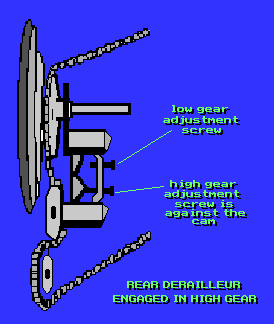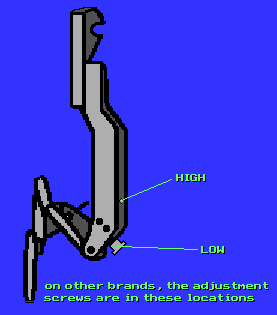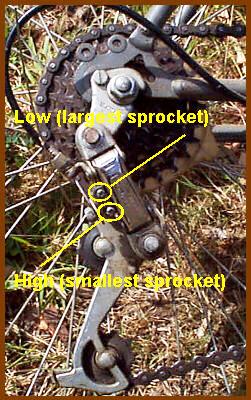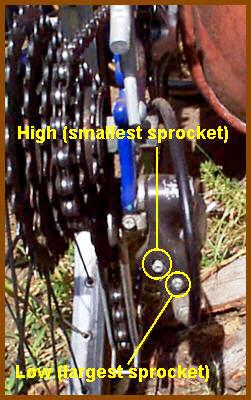Bicycle Tune-Up Step 7 - Adjust The Rear Derailler
Notice the two small screws on the body of the rear derailler. (Some Suntour models have three screws. Ignore the top one for now.) The high gear limit screw stops the derailler from shifting past high gear (smallest sprocket), and the low gear screw prevents it from going past low gear (largest sprocket). If a limit screw is too loose, the chain will fall off. If too tight, the system will not engage the gear.

Locations of the adjustment screws will vary on different brands, but they all function the same way.



1. Tighten the high gear screw, the one that hits a cam when you shift to the smallest sprocket, until you can no longer shift into high gear. Put the shifter in high gear position and while turning the pedals, unscrew the high gear screw until the system engages high gear again. Shift between high gear and the second smallest several times, backing the screw out a little more, just until the derailler shifts smoothly.
2. Tighten the low gear screw until you no longer get first gear. Repeat the process for this low gear limit - back the screw out just until the bike shifts smoothly from the second largest to the largest sprocket.
3. If you cannot engage high or low gear, or if the above technique does not work for high or low gear, the cable may be improperly adjusted.
Shift into high gear and push the shifter all the way to the end of its travel. Loosen the cable inner wire anchor bolt. That's the bolt with a hole through which the derailler control wire is clamped. Pull the slack out of the wire, and retighten the anchor bolt.
If your bike has index shifting, you'll find an adjusting barrel either at the derailler or the shifter. The adjusting barrel is a hollow screw at which the cable outer housing stops, but which the inner wire continues through. Fine adjust the cable tension by turning the adjusting barrel until the clicks on the shifter correspond with proper shifting at the derailler.
If your bicycle does not engage high gear, or is slow to engage high gear, even though properly adjusted, the cable is probably the culprit. Replace the sticky or rusted cable, and the problem will usually go away.
If you have done everything right, but the bicycle does not shift reliably, the most common reason is that the chain and freewheel are too worn to work properly. If you replace one, you must replace both. A new chain on an old freewheel or visa versa usually skips, and the new part wears out very quickly.
Another possibility is a bent derailler. The guide pulleys, those little wheels that take up the chain slack, must pivot on the same plane as the freewheel sprockets. Deraillers become bent when the bike falls over on the right-hand side. Whenever you set a bicycle down, or put it in a car, set it on its left side to protect the derailler. You can sometimes straighten out a bent derailler by simply bending it back and readjusting the limit screws.
Update: A reader brought to my attention that there is a third screw that I need to address. This is the "b" screw or "chain gap adjustment" screw. It is located right where the derailleur attaches to the hanger and actually pushes the derailleur back in order for the derailleur to keep from contacting the cassette. Simply move your chain to the largest gear and then adjust this screw to barely keep the derailleur from coming into contact with the cassette. Simple! (Carl)
The following situations indicate that the cable needs replacing:
1. The rear derailler easily engages low gears (large sprockets) but hesitates to engage the smallest sprocket, or doesn't engage it at all. This is after the high gear adjustment has been set, as in the above paragraphs.
2. The shifter is very hard to move. Make sure that the reason is not just that the shifter friction adjustment has been set too tight. Some shifters have a large screw or wingnut that can be adjusted. When too loose, the shifter slips back into high gears when you hit bumps. When too tight, the shifter is hard to move.
3. If you see broken strands on a cable inner wire, it should be replaced. A cable with just one broken strand is less than half as strong as one that's intact.
Click here for cable maintenance and replacement information
|
Hello
Jeff
I have read through your web site with much interest, and found your repair section very descriptive and helpful, with very accurate explanations on what to do and how to do it. I am a racing cyclist in South Africa and have been maintaining my own bike now for the last 10 years. I began repairing and maintaining my bike because every time I sent my bike in to a bike shop for a service it came back in a worse condition...gears not being set, brakes not working, etc. I am now at the stage where I feel comfortable enough to build my own bikes (not the frames). Ok, that's the background, now the main problem: when adjusting the rear derailler (STi or ErgoPower) I usually find that one of the gears (usually about the 6th one up) lags a bit. All the other gears change smoothly and crisply then it just hesitates for a moment on this one gear. What could the problem be? Over the weekend I was looking at the whole setup and decided to adjust a screw which I have never really played with before and it seemed to help a little, but I am scared to say that I have found the problem, so the secon question is: what is the screw on the back of the derailler, which adjusts against the frame (hanger), for? I would be very happy if you could finally solve my little dilemma for me... Hi Sheldon,
The 'third' screw, at the derailler hanger
adjusts the angle of the derailler body. Supposedly, it can bring the
derailler guide pulley closer to a close-range freewheel, and farther
away to accomodate a wide-range freewheel, but in most cases, it makes
little difference and is seldom used.
As I understand your problem, the bike is slow
to shift into the smallest rear sprocket. The most common case is a
sticky cable. Replace the cable, and the problem may go away. However,
it could be simply that the high gear limit screw is set too close -
so you may try loosening that first, as I believe you said you
were experimenting with.
Finally, if the chain is quite worn, you can
have shifting slowness as you described.
Have fun!
- Jeff -
|
3
Things You Need To Know
Before You Buy Cycling Gear
& Parts!
![]()
Next - Front Derailler Adjustment
Tell a Friend About BikeWebSite
Please feel free to link your web pages to www.bikewebsite.com.
![]()